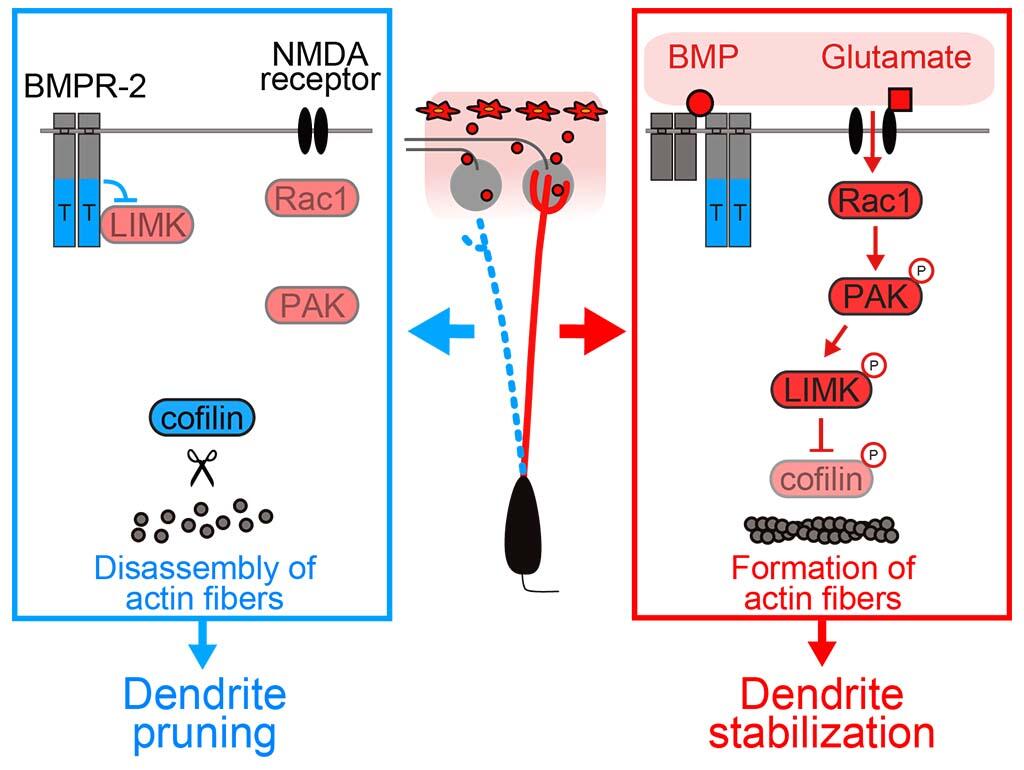As a result of the pruning and strengthening of synapses that occur during postnatal development, only the "correct" circuitry remains in the brain. However, the process by which the dendrites to be reinforced are selected is yet unknown. A study group comprising Professor Takeshi Imai, former graduate student Shuhei Aihara, Assistant Professor Satoshi Fujimoto, and former graduate student Richi Sakaguchi of the Kyushu University Graduate School of Medicine clarified molecular mechanisms by which specific dendrites are selectively strengthened during development using neurons and mitral cells in the olfactory bulb, which processes odor information, as a model. "We found that dendrites are strengthened only when there are both secretory BMP (bone morphogenetic protein) and neurotransmitter glutamate inputs and that pruning occurs in the absence of an input," said Dr. Aihara. "If glutamate is an accelerator, BMP acts as a clutch." The group's research was published in Cell Reports.
Developmental pruning and strengthening occur in all types of neuronal cells, but studies to date were focused on the sense of smell. In the sense of smell, each odorant is received by a group of corresponding olfactory nerve cells that transmit the signal to a single glomerulus. The glomerulus then sends that information to a corresponding mitral cell. Glomeruli and mitral cells are connected by a single principal dendrite, and mitral cells receive only specific odor information.
In mice, 1 day after birth, mitral cells extend multiple dendrites to different glomeruli. However, by day 6 post-birth, only one dendrite is strengthened, and connections to other dendrites are pruned. To investigate how mitral cells selectively undergo dendritic reorganization, the research group knocked out 38 genes and analyzed their effects on dendritic shape changes. They found that the receptor BMPR2 of secretory BMP is involved in dendritic reorganization.
A detailed examination of intracellular signaling pathways of BMPR2 revealed that the intracellular domain tails of BMPR2 are involved. In the absence of BMP, the protein LIMK is constantly repressed by the tail of BMPR2, and this repression is only disinhibited when BMP binds to BMPR2. However, removing the repression of LIMK alone does not lead to dendritic morphological changes. LIMK is activated upon entry of neurotransmitter glutamate inputs from dendrites, facilitating the assembly of actin fibers. Experiments using genetic manipulation, FRET imaging, and actin fiber visualization have shown that an input from NMDA-type receptors, a type of glutamate receptor, activates LIMK via intracellular molecules Rac1 and PAK, and this signal promotes the formation of actin fibers. They also found that actin fibers were not formed when the BMP input was blocked.

Credit: Kyushu University
These findings indicate that binding of BMP to BMPR2 leads to release of LIMK, activation of LIMK by a glutamate input, and enhancement of dendrites by activated LIMK promoting the formation of actin fibers. In other words, inputs of both BMP and glutamate, not just one or the other, are required for dendrite strengthening.
"For example, glutamate inputs act as the 'gas pedal' for dendrite reinforcement, whereas BMPR2 serves as the clutch that transmits the signal into cells," Dr. Aihara said. "Considering the experimental evidence that BMPs are secreted from the surface of the olfactory bulb and that glutamate is secreted by the superficial glomeruli of the olfactory bulb, it seems that only dendrites extending to the surface of the olfactory bulb enter accessions and clutches, getting strengthened or pruned."
"BMPR2 contributes to neuronal circuitry abnormalities in fragile X syndrome, a type of neurodevelopmental disorder," Professor Imai said. "This discovery may help us gain new understanding of the mechanisms of neurodevelopmental disorders and help develop novel treatments. Neuronal strengthening and pruning are also used to create memories. If the aforementioned 'gas-clutch' relationship can be revealed in other neurons, such as those in the cerebral cortex, we could expand our findings to encompass various neuropsychiatric disorders."
This article has been translated by JST with permission from The Science News Ltd.(https://sci-news.co.jp/). Unauthorized reproduction of the article and photographs is prohibited.




